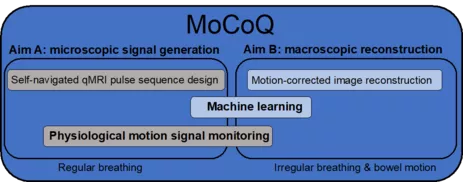MoCoQ
Project: Motion-Corrected Quantitative Body MRI
Collaborating Departments: Department of Diagnostic and Interventional Radiology (TUM); Department of Computing (Imperial)

The prevalence of pathologies of the gastrointestinal tract is on the rise. Computed Tomography (CT) occupies a central role in the clinical decision process despite the radiation exposure and the need for contrast agent injection. Gastrointestinal tract Magnetic Resonance Imaging (MRI) has superior soft tissue contrast to CT but suffers from limited resolution and artifacts due to involuntary gastrointestinal movements and respiration. Nevertheless, quantitative MRI techniques based on relaxometry mapping have shown great successes for tumor staging and therapy outcome assessment. Current quantitative abdominal MRI protocols rely on 2D acquisitions performed during breath-holds or using traditional respiratory motion synchronization, e.g. gated image acquisition driven by external sensors. Abdominal physiological motion is complex. Traditional gating techniques are not sufficient to achieve robust image quality across patients and can lead to prolonged inefficient scans for quantitative imaging. MoCoQ aims to develop contributions on two distinct levels: 1) Aim A, microscopic signal generation including machine learning-enhanced self-navigated data acquisition, physiological monitoring techniques and quantitative parameter mapping and 2) Aim B, macroscopic image reconstruction using generative machine learning models, in order to reconstruct plausible high-resolution and motion-free abdominal MR images at a quality level that competes with CT. MoCoQ relies on a multidisciplinary research team bringing together expertise on quantitative MRI data sequence design (TUM) and on machine learning informed motion-corrected image reconstruction (Imperial).
Our project on "Motion-Corrected Quantitative Body MRI (MoCoQ)" from the 2020 TUM-Imperial JADS cohort is advancing with parallel developments on MRI technology and machine learning methodology. The TUM partners have developed a free-breathing quantitative relaxometry methodology targeting whole-liver T1 and T2 mapping for the characterization of diffuse and oncological liver diseases. The Imperial partners have developed a machine learning-based motion correction methodology for super-resolved bowel MRI. The first six-month doctoral candidate exchange took place at Imperial College in 2023. Future works aim to improve the MR acquisition and to develop physics-informed machine learning-based reconstruction and post-processing techniques.
W. Zhang, J. Stelter, C. Ouyang, D. C. Karampinos, B. Kainz (2023): UTAR: Source-free Unsupervised Test-time Adaptation for MRI Super-Resolution, Med-NeurIPS, NeurIPS, New Orleans, United States, December 16.
W. Zhang, J. Tan, M. Baugh, L. Li, J. K. Stelter, P. Lung, U. Patel, D. C. Karampinos, B. Kainz, MoCoSR (2023): Respiratory motion correction and super-resolution for 3D abdominal MRI, Medical Image Computing and Computer Assisted Intervention–MICCAI 2023: 26th International Conference, Vancouver, Canada, October 8-12.
T. Straßer, J. Stelter, V. Spieker, K. Weiss, R. Braren, J. Schnabel, D. C. Karampinos (2023): On the variations of liver B0 inhomogeneities within the respiratory cycle at 3T, Annual Meeting of ESMRMB, Basel, Switzerland, October 4-7.
J. K. Stelter, M. Wu, J. Raspe, P. Braun, C. Boehm, K. Weiss, D. C. Karampinos, Dixon-based B0-navigation to correct B0 drift and B0 fluctuations in radial stack-of-stars multi-echo gradient echo imaging, Proc of 2023 Annual Scientific Meeting of ISMRM, p. 1154, Toronto, Canada, June 3-8. [ISMRM Summa Cum Laude Merit Award]
J. K. Stelter, K. Weiss, E. Huaroc Moquillaza, F. N. Harder, M. R. Makowski, R. F. Braren, D. C. Karampinos (2023): Free-breathing Isotropic resolution self-Navigated B1-insensitive whOle liver simultaneous T1 and T2 mapping (FINO), Proc of 2023 Joint Annual Meeting of ISMRM, p. 60, Toronto, Canada, June 3-8.
J. K. Stelter, K. Weiss, M. R. Makowski, R. F. Braren, D. C. Karampinos (2022): Free-breathing self-gated water-specific volumetric whole liver T1 and T2 mapping at isotropic resolution, 2022 ISMRM Workshop on Motion Detection & Correction, Oxford, UK, August 30-September 2.
M. Zamskiy, K. Weiss, F. N. Harder, S. Ruschke, M. R. Makowski, R. F. Braren, D. C. Karampinos (2022): Isotropic resolution volumetric liver T2 mapping using a free-breathing navigator-gated radial stack-of-stars T2-prepared Dixon acquisition, Proc of 2022 Joint Annual Meeting ISMRM-ESMRMB, p. 2286, London, UK, May 7-12.
W. Zhang, B. Hou, L. Li, M. Baugh, P. Lung, U. Patel, B. Kainz (2022): Motion correction and deep consistency network for super-resolution of 3D bowel MRI, 2022 ISMRM Workshop on Motion Detection & Correction, Oxford, UK, August 30-September 2.
Team

Principal Investigator (Imperial)
Dr. Bernhard Kainz
Senior Lecturer in Medical Image Computing | Imperial

Principal Investigator (TUM)
Prof. Dr. Dimitrios Karampinos
Experimental Magnetic Resonance Imaging

Doctoral Candidate (Imperial)
